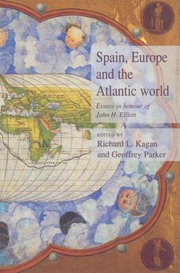Book contents
- Frontmatter
- Contents
- Notes on contributors
- Acknowledgements
- List of abbreviations
- Sir John Elliott: an appreciation
- Introduction
- PART I Power and propaganda: the world of the court
- PART II The pattern of society: community and identity in Habsburg Spain
- 4 Toledanos and the kingdom of Granada, 1492–1560s
- 5 Castile, Spain and the monarchy: the political community from patria natural to patria nacional
- 6 Aragonese constitutionalism and Habsburg rule: the varying meanings of liberty
- 7 Patriotism in early modern Valencia
- 8 The mental world of Jeroni Pujades
- 9 Centring the periphery: the Cerdanya between France and Spain
- PART III Spain and its empire
- Index
4 - Toledanos and the kingdom of Granada, 1492–1560s
Published online by Cambridge University Press: 04 August 2010
- Frontmatter
- Contents
- Notes on contributors
- Acknowledgements
- List of abbreviations
- Sir John Elliott: an appreciation
- Introduction
- PART I Power and propaganda: the world of the court
- PART II The pattern of society: community and identity in Habsburg Spain
- 4 Toledanos and the kingdom of Granada, 1492–1560s
- 5 Castile, Spain and the monarchy: the political community from patria natural to patria nacional
- 6 Aragonese constitutionalism and Habsburg rule: the varying meanings of liberty
- 7 Patriotism in early modern Valencia
- 8 The mental world of Jeroni Pujades
- 9 Centring the periphery: the Cerdanya between France and Spain
- PART III Spain and its empire
- Index
Summary
The centre–periphery balance within the Iberian peninsula was one of shifting fortune and power, but few would deny that during the reign of the Catholic Monarchs the balance shifted toward the centre. The territorial expansion of the crown of Castile in these years was dramatic: the conquest of the Canary Islands, the reconquest of kingdom of Granada, and the discovery of the New World. In this same period an internal expansion began that lasted until the later years of Philip II's reign: by the 1560s many Castilian cities had doubled in size, and the local economies prospered.
This is certainly the case for Toledo, the most important city of the central region and, with a population of some 55,000 souls in 1561, also the largest. Despite setbacks – the arrival of the Inquisition and the onus of fighting on the losing side in the comunero revolt – the city successfully exploited the opportunities offered in the new territories and met the challenges posed by an increasing population. Part of the credit for this positive response belongs to the city's active middle class citizens. They provided the money, expertise and energy to build up the local cloth industries, and they supplied the skills necessary to satisfy the ever increasing demand for men trained to keep records and accounts, to read, analyse and write reports and to administer finances, whether on the local level or in distant outposts.
- Type
- Chapter
- Information
- Spain, Europe and the AtlanticEssays in Honour of John H. Elliott, pp. 103 - 124Publisher: Cambridge University PressPrint publication year: 1995



